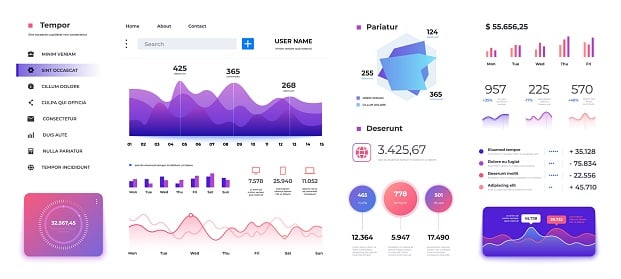
The New Analytics Companies Use to Explode B2B Lead Generation Results
Strategy, Tactics And Technology Are Changing Very Quickly, But Analytics Are Evolving, Too
Regardless of the strategy, tactics and tools you use, if your analytics are not designed properly, you’ll struggle to generate leads. That’s because your program will lack the ability to show you what’s working, what’s not working as well as expected and what might not be working at all.
Most marketing pros are solid on the basics when it comes to analytics. This includes website visitors by source, email campaign performance, video views, page views, page conversions, number of leads and the performance of paid campaigns like Google Ads or social paid programs.
But that’s not enough anymore.
Today, and especially going into 2021, you’re going to have to look a little harder and take a second-level look at the performance of your marketing and lead gen tactics if you want to uncover the insights you’ll need to make 2021 your best year ever.
Here are some of the advanced analytics we’re using with clients.
Revenue Cycle Modeling
Before we get into specific metrics and numbers you might be more comfortable with, let’s pull back and look at the big picture in a slightly different way, one that keeps revenue in focus as opposed to specific marketing metrics.
The revenue cycle model we do for clients does exactly this.

The image here shows you what a high-performing revenue cycle should look like. You’ll notice that the conversion rates are reasonable across the entire cycle. There is strategy and thinking behind each (that information is discussed in article after article on our site).
The short story is if you did everything we told you to do month in and month out, you could get a website with 5,000 visitors a month to generate three new customers a month.
Now let’s use that thinking to look closer at specific analytics.
Percentage Of Website Visitors To Sales-Qualified Leads
This metric shows you how good your marketing is at producing people who want to talk to your sales team. Yes, we’re focusing on your website, but remember that all of your marketing should be designed to get people to your website.
Using the revenue cycle above, this metric is .3%. This means that .3% of everyone who comes to your website ends up wanting to talk to your sales team.
It might sound like a small number, but it’s not. And once you start tracking it, and in turn actively working to improve it, the opportunity to dramatically improve the effectiveness of your marketing to generate leads will follow.
Site-Wide Landing Page Conversion Rate
Now we’re going to talk about the first part of the revenue cycle. How good is your website at taking anonymous visitors and turning them into contacts and marketing-qualified leads (MQLs)?
The best place to look for data here, and by far the best place to uncover insights that can improve this important metric, is your landing pages.
Every website should have landing pages. These pages are different than your regular website pages. They are not informational pages. They have only one mission, and that is to turn anonymous visitors into identified contacts and leads.
The revenue cycle shows site-wide conversion rate, which is valid metric. It shows how the site is doing across all types of pages.
But by looking at landing pages specifically, you can see how those unique pages are doing their job.
Square 2 clients do appear to see a higher-than-average conversion rate on landing pages. We’re shooting for 20% or more on our landing pages, and I’ve seen client landing pages that do over 50%.
Looking at all landing pages in the aggregate will show you how you’re doing across the site. Digging into individual landing pages will give you direction on which pages need your attention and in what priority.
When we build client programs for our 30-day sprints, we often look for highly visited landing pages with lower-than-acceptable conversion rates and focus initial efforts on improving those pages. This almost always produces a lift in leads generated.
Conversion Rate On Late-Stage Buyer Journey Offers
All offers are not created equally. Whitepapers and infographics are fine for people early in their buyer journeys, but if you want to turbocharge the sales effort, you’ll need late-stage buyer journey offers, and most marketers overlook this.
Clients typically make fairly significant mistakes here. They use Contact Us, Speak With A Rep, Schedule An Appointment, Request A Quote and other traditional sales-oriented offers that usually fail pretty epically. Even Schedule A Demo is a sales call dressed in sheep’s clothing, and everyone knows it.
Face it – people don’t want to talk to a sales rep anymore.
Demo request pages deliver a 1% to a 10% conversion rate. This supports the idea that people aren’t interested in seeing your demo, at least not until they are further along in their buyer journey.
Interestingly enough, Lucky Orange, the heat-mapping software company and a Square 2 partner, did a test. They found when comparing a demo request page to a video demo offer page the data showed a 1% conversion rate on the demo page and a 15% conversion rate on the video demo page.
Again, people want value from these calls.
We spend a lot of time helping clients create late-stage buyer journey offers that add value. These offers should be tracked on a weekly basis, aggregated to see how they are doing as a group and then optimized quickly to produce even better results.

Leads Generated By Visitor Source (MQLs And SQLs)
Marketing people are pretty good about looking at visitor source data, but you also want to look at the source of your marketing-qualified leads (MQLs) and your sales-qualified leads (SQLs). This is going to tell you what sources are providing leads and what sources are generating sales-qualified leads.
Its these sources that you’ll then want to lean in on and optimize to improve performance or give up on altogether.
Yes, giving up is an option. In many cases, companies don’t have the budget, resources or energy to work on everything. Picking and choosing or prioritizing based on data is a big part of how you generate results.
Knowing which sources are kicking in MQLs and SQLs will help you lean into those that are doing well, look more closely at those that should be performing better and then make hard decisions about sources that just don’t seem to be working regardless of how much effort you exert.
For example, social media as a source does very little for Square 2, so we’ve automated much of our social posting to keep the effort level down. Email also is generally a low source for us. Again, we’re doing emails but limiting the effort to improve results.
Now this doesn’t mean you’re going to always take this approach. In November, we’re running a test to see if concerted efforts around social can improve our visitors and leads from social. If it works, we’ll continue the effort, but if it doesn’t, we might go back to a more automated approach.
The analytics should be informing your own tests and experiments, too. Make testing and experiments part of your standard operating procedure (SOP). Identify areas that could be performing better. Create the experiments, define the potential results, run the experiments and compare the results to your expected results.
Once you get good at this, your tactics are going to improve.
Leads Generated By Stage Of The Cyclonic Buyer Journey™ (MQLs And SQLs)
The last set of innovative analytics has to do with your prospects’ buyer journeys. It’s pretty typical to look at analytics by tactic, such as email campaign analytics, SEO analytics, analytics for paid ads or social media analytics.
But we find way more value and many more insights when we look at program analytics by stage of the buyer journey.
Here are a couple of examples. In the Pre-Awareness Stage, the metrics and analytics are very tuned into account-based marketing (ABM) campaigns and general demand generation tactics.
You’re looking at metrics like connect rates on targeted accounts and engagement rates on those same targeted accounts. Ultimately, this informs how you’re doing at generating leads and sales opportunities uncovered from those targeted accounts.
In the Education Stage, the metrics shift to the effectiveness of your content and website pages to create new leads. We’re looking at landing page conversion rates and overall improvement on landing page conversions.
Other examples include the performance of CTAs on the website, the number of views for educational videos, the performance of lead nurturing campaigns designed to move people from the Education Stage to the Consideration Stage and the overall conversion rate from one stage to the other.
These analytics tell us how well our Education Stage tactics are moving prospects through this stage of the buyer journey and into the next. Ultimately, how many leads did we generate from prospects in this stage?
Overall, B2B lead generation is changing very quickly. Strategy, tactics, analytics and technology are supporting a rapid evolution of how marketers and salespeople build a repeatable, scalable and predictable revenue engine for their B2B companies.

CEO and Chief Revenue Scientist
Mike Lieberman, CEO and Chief Revenue Scientist
Eliminate Hit-or-Miss Marketing Moves
Get advice, tips, tools and guidance to generate more leads for your company in this weekly email newsletter.



Eliminate Hit-or-Miss Marketing Moves
Get advice, tips, tools and guidance to generate more leads for your company in this weekly email newsletter.













